
- Bijapur Fort, Bijapur
- Bijapur Fort - Home
- Bijapur Fort - Overview
- Bijapur Fort - History
- Bijapur Fort - Architecture
- Bijapur Fort - How to Reach?
- Bijapur Fort - Nearby Places
- Bijapur Fort Resources
- Bijapur Fort - Quick Guide
- Bijapur Fort - Useful Resources
- Bijapur Fort - Discussion
Bijapur Fort - Architecture
Bijapur fort is a very big fort with many structures inside. The fort was built in 1565 by the founder of the Adil Shahi dynasty. There are 96 bastions of various designs within the fort. Spaces were provided within the bastions to drop stones or cannons. These spaces are known as crenulations and machicolations. There are five main gates of the fort and each has ten bastions. A moat surrounds the fort which was made so that enemy could not enter the fort. The moat has the width of 50 feet.
Gates of the Fort
The fort can be entered through five gates which are located in every direction. The gates with their directions are as follows −
- Makka gate in the west
- Shahpur gate in the northwest
- Bahmani gate in the north
- Allahpur gate in the east
- Fateh gate in the southeast

Jamia Masjid
Jamia Masjid is located in the southeast direction of the fort. The construction of the mosque was started in 1565 but could not be completed. The arcaded prayer hall has aisles having a dome with nine bays. The aisles are supported on pillars. The mosque also has a large courtyard with water tank. The mosque is also known as Jumma Masjid as khutba or speech related Islamic traditions is read on every Friday.
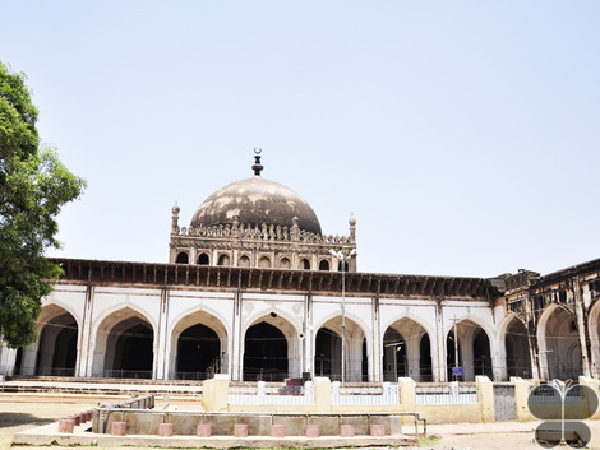
The area covered by the mosque is 10810m2. The rectangular-shaped mosque has the dimensions of 170m x 70m. There are nine arches and five arches are within them that divide the mosque into 45 compartments. There are 2250 tiles which are laid in the form of a prayer mat. The tiles were constructed by Aurungzeb.
Ibrahim Rauza or Ibrahim Tomb
Ibrahim Rauza was built in 1627 and has the graves of Ibrahim Adil Shah II and Queen Taj Sultana, his wife. The tomb is built in the form of twin buildings with carvings. Malik Sandal, the architect of this tomb, is also buried here. There is a mosque and a garden inside the tomb that face each other.
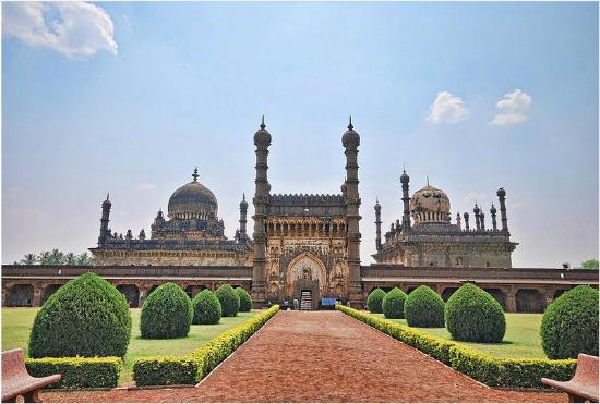
The size of the garden is about 140m2. The ceiling of the tomb is divided into nine squares whose sides are curved. There are four minarets, one on each corner of the tomb. Tourists can reach the tomb through the steps provided below the platform on which the tomb is situated. The mosque in the tomb has gateways made up of teak wood and are decorated with metal strips.
Mehtar Mahal
Mehtar Mahal was constructed in 1620 whose gate is built in Indo-Saracenic style. There is a mosque inside the mahal called Mehtar Mosque which has three storeys. The minarets of the mahal are carved with rows of swans and birds. The mahal has flat roof and the minarets have rounded tops.
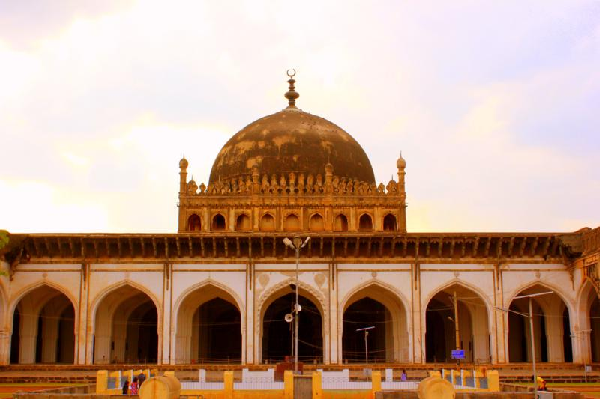
Barakaman
Barakaman was built in 1672 as a tomb for Ali Roza. Previously, the structure was known as Ali Roza but later its name was changed to Barakaman by Shah Nawab Khan. Barakaman has 12 arches and was built during the reign of Shah Nawab Khan. The structure was built on a raised platform and covers an area of 66m2. The arches were built by using black basaltic stone. Ali Roza, his queens and some other ladies are buried in the tomb.
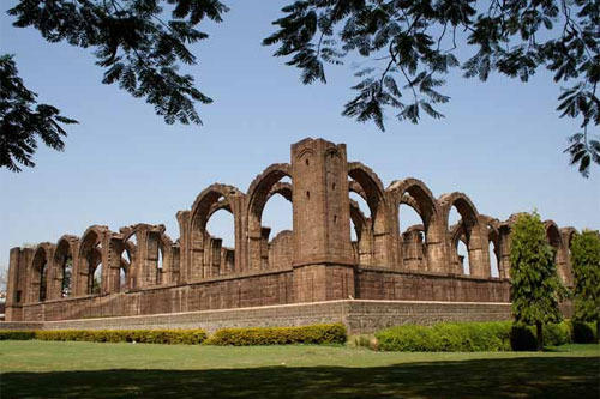
Malik-e-Maidan
Malik-e-Maidan was constructed by Ibrahim Adil Shah II after the battle of Talikota. The structure is also known as Burj-e-Sherz. It has a large cannon having length of 4.45m and diameter of 1.5m. The weight of the cannon is 55 tonnes. The gun remains cool even during summers and produces sound when tapped.
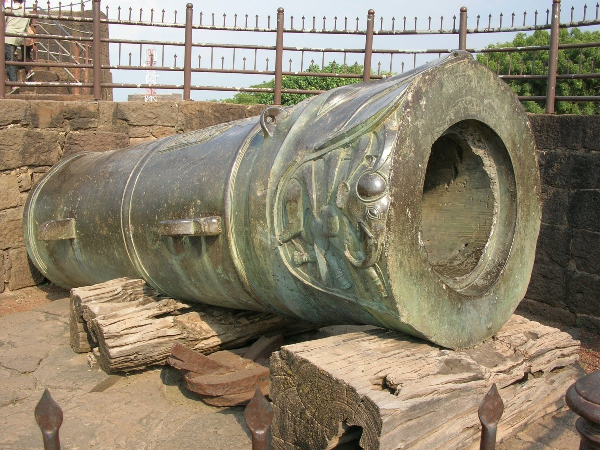
Gagan Mahal
Adil Shah I built the Gagan Mahal or Heavenly Palace in 1561. The palace has three arches out of which the central arch is the widest. The palace has ground and first floor which are now ruined. The ground floor had a darbar hall while the first floor had private residences.
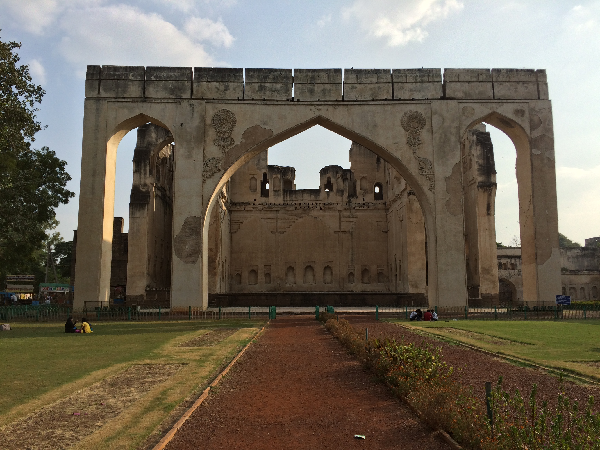
Sat Manzil or Seven Storey
Sat Manzil was a seven storey palace which was built by Ibrahim Adil Shah II in 1583. Currently only five floors are there.
Asar Mahal
Asar Mahal is can be found on the east of the citadel and was built in 1646. The palace is connected to the fort through a bridge. It was also used as a court so it was called Dad Mahal. It is also considered as a shrine as it is believed that it has two hairs of Prophet Muhammad. There are four octagonal columns with ceiling having wooden panels. Women are not allowed to enter the palace.

Taj Bawdi
Taj Bawdi was built in the memory of Taj Sultana who was the first wife of Ibrahim Adil Shah. II. The bawdi has octagonal towers whose east and west wings were used as rest houses.
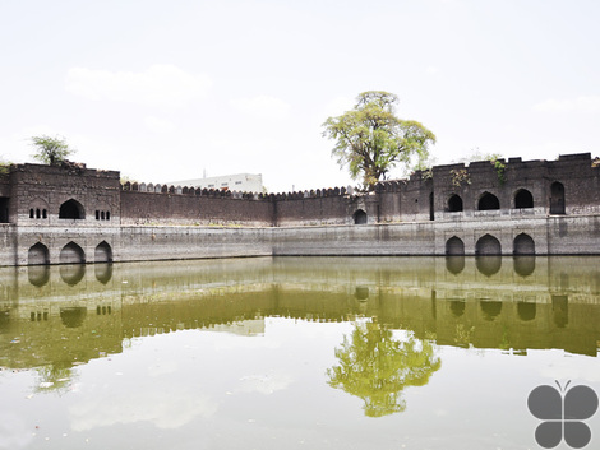
To Continue Learning Please Login